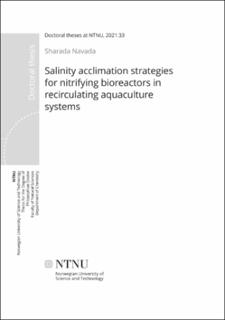| dc.contributor.advisor | Mikkelsen, Øyvind | |
| dc.contributor.advisor | Vadstein, Olav | |
| dc.contributor.advisor | Kolarevic, Jelena | |
| dc.contributor.advisor | Gaumet, Frederic | |
| dc.contributor.author | Navada, Sharada | |
| dc.date.accessioned | 2021-02-23T13:05:50Z | |
| dc.date.available | 2021-02-23T13:05:50Z | |
| dc.date.issued | 2021 | |
| dc.identifier.isbn | 978-82-471-4978-2 | |
| dc.identifier.issn | 2703-8084 | |
| dc.identifier.uri | https://hdl.handle.net/11250/2729848 | |
| dc.description.abstract | The demand for seafood is rising like never before, and unsustainable fishing has depleted the oceans. Recirculating aquaculture systems (RAS) can present a sustainable solution by producing seafood in land-based systems with water treatment and reuse. At the heart of the RAS water treatment system is the nitrifying bioreactor. The bioreactor contains microbes that remove the ammonia produced by the fish, thus maintaining the ammonia concentration at safe levels for the fish.
Atlantic salmon are typically reared in freshwater RAS until they are seawater-adapted (smoltified), and then transferred to sea-cages for further growth and harvest. Several factors have led to an increasing interest in growing salmon to a larger size in RAS. As smoltified fish prefer higher salinities, this requires the salinity to be changed from freshwater to saline water during the fish production cycle. Salinity variations can greatly inhibit the bioreactor’s performance, causing ammonia and/or nitrite accumulation in the RAS. As both these compounds are extremely toxic to fish, it is vital to maintain the nitrification performance during salinity changes.
My aim was to develop strategies to acclimate the bioreactor, so that salinity changes may be conducted safely for the fish. My Industrial PhD was established as a collaboration between Nofima, Krüger Kaldnes AS, and NTNU, and was a part of CtrlAQUA SFI - Centre for Research-Based Innovations in Closed-containment Aquaculture.
In my thesis, I investigate strategies that can improve the performance of bioreactors under varying salinities. More importantly, I propose several strategies that can be practically applied in industrial RAS to augment the bioreactor performance, and thereby, improve fish production and welfare. While the strategies were motivated by the challenges in RAS, they can also be applied in the treatment of high or variable salinity effluents produced by other industries. My research also provides a deeper insight into the microbial composition under salinity changes. As such, I hope that my findings will satisfy an audience interested in the engineering applications, as well as those curious about the microbes that can explain the science behind these applications. | en_US |
| dc.language.iso | eng | en_US |
| dc.publisher | NTNU | en_US |
| dc.relation.ispartofseries | Doctoral theses at NTNU;2021:33 | |
| dc.relation.haspart | Paper 1:
Navada, Sharada; Vadstein, Olav; Tveten, Ann-Kristin; Verstege, Gerhardus C.; Terjesen, Bendik Fyhn; Mota, Vasco C.; Venkatraman, Vishwesh; Gaumet, Frederic; Mikkelsen, Øyvind; Kamstra, Andries.
Influence of rate of salinity increase on nitrifying biofilms. Journal of Cleaner Production 2019 ;Volum 238. s. 1-10
https://doi.org/10.1016/j.jclepro.2019.117835
This is an open access article under the CC BY-NC-ND license (http://creativecommons.org/licenses/by-nc-nd/4.0/). | |
| dc.relation.haspart | Paper 2:
Navada, Sharada; Vadstein, Olav; Gaumet, Frederic; Tveten, Ann-Kristin; Spanu, Claudia; Mikkelsen, Øyvind; Kolarevic, Jelena.
Biofilms remember: Osmotic stress priming as a microbial management strategy for improving salinity acclimation in nitrifying biofilms. Water Research 2020 ;Volum 176. s. 1-9
https://doi.org/10.1016/j.watres.2020.115732
This is an open access article under the CC BY-NC-ND license (http://creativecommons.org/licenses/by-nc-nd/4.0/). | |
| dc.relation.haspart | Paper 3:
Navada, Sharada; Sebastianpillai, Marianna; Kolarevic, Jelena; Fossmark, Ragnhild Olsen; Tveten, Ann-Kristin; Gaumet, Frederic; Mikkelsen, Øyvind; Vadstein, Olav.
A salty start: Brackish water start-up as a microbial management strategy for nitrifying bioreactors with variable salinity. Science of the Total Environment 2020 ;Volum 739. s. 1-11
https://doi.org/10.1016/j.scitotenv.2020.139934
This is an open access article under the CC BY license (http://creativecommons.org/licenses/by/4.0/). | |
| dc.relation.haspart | Paper 4:
Navada, Sharada; Gaumet, Frederic; Tveten, Ann-Kristin; Kolarevic, Jelena; Vadstein,Olav.
Seeding with brackish-water biofilm as a startup strategy for salinity acclimation in freshwater
nitrifying bioreactors | |
| dc.relation.haspart | Paper 5:
Navada, Sharada; Laureni, Michele; Vadstein, Olav;
van Loosdrechtc, Mark.
Investigating the exogenous addition of osmolytes as a salinity acclimation strategy in nitrifying
biofilms | |
| dc.title | Salinity acclimation strategies for nitrifying bioreactors in recirculating aquaculture systems | en_US |
| dc.type | Doctoral thesis | en_US |
| dc.subject.nsi | VDP::Mathematics and natural science: 400::Chemistry: 440 | en_US |
